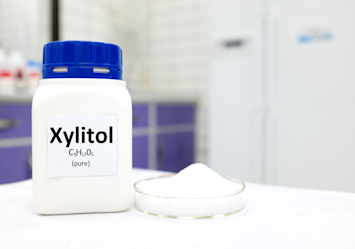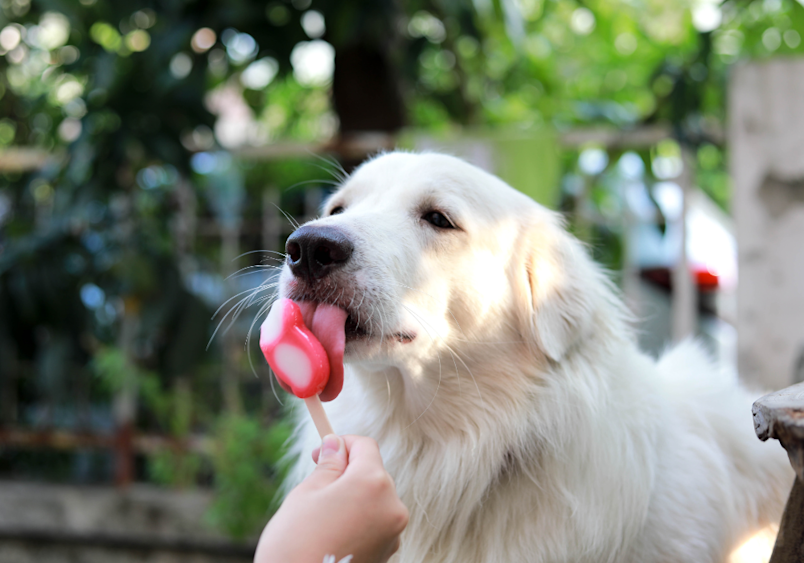
You might already be cautious about what your dog eats, but did you know that something as ordinary as sugar-free gum could pose a life-threatening danger to your dog? Is coffee bad for dogs? Absolutely, just like xylitol, caffeine can be toxic for dogs, making everyday items in your home potential hazards. Xylitol, a common sugar substitute, is extremely toxic to dogs, and even small amounts can cause serious harm. It can lead to a dangerous drop in blood sugar, followed by symptoms like vomiting, weakness, seizures, and in severe cases, liver failure.
Here’s what you need to know to protect your dog from this hidden danger, recognize the signs of xylitol poisoning, and prevent a medical emergency before it’s too late.
How Xylitol Affects Your Dog
While many dog owners are aware that chocolate can be toxic to dogs, fewer know about the dangers of xylitol. This sweetener is found in everyday products like gum, toothpaste, and even some peanut butters.
When your dog accidentally ingests xylitol, their body confuses it for glucose (sugar) and releases a large amount of insulin. This surge of insulin causes blood sugar levels to plummet dangerously low, a condition known as hypoglycemia. If untreated, xylitol poisoning can lead to seizures, liver failure, or even death. The scary part? It doesn’t take much. Just a single piece of gum containing xylitol can be fatal for a small dog.
How Much Xylitol is Toxic to Dogs?
You’re probably wondering, “How much is too much?” The amount of xylitol that can be toxic to your dog can vary based on your dog’s size and the concentration in the product consumed. Here’s a general idea of how little it takes:
As little as 0.1 grams per kilogram of your dog’s body weight can cause hypoglycemia (a rapid drop in your dog’s blood sugar)
For a 10-pound dog, that’s about 0.45 grams – a tiny amount!
For a 50-pound dog, only 2.25 grams could trigger toxicity.
To better picture this out, a single piece of sugar-free gum can contain up to 1 gram of xylitol, meaning even one or two pieces of gum could be dangerous, depending on your dog’s size.
How Much Xylitol Can Kill a Dog?
The same amount of xylitol that can make a dog sick can also kill them. When a dog ingests xylitol, their body mistakenly releases a large amount of insulin, leading to a rapid drop in blood sugar levels. This condition, known as hypoglycemia, can cause a range of symptoms, including weakness, lethargy, seizures, and in severe cases, liver failure. If left untreated, hypoglycemia can be fatal.
Keep in mind that these are just estimates. Individual factors like your dog’s health, metabolism, and the specific xylitol-containing product can influence how their body reacts.
The key takeaway is that even small amounts of xylitol can be dangerous for dogs. If you suspect your dog has ingested any amount of xylitol, seek veterinary attention immediately. Don’t wait for symptoms to appear, as early intervention is crucial.
"My Dog Ate Xylitol and Is Fine"– Is That Really True?
Even if your dog seems fine after ingesting xylitol, it's crucial to seek veterinary attention immediately. While some dogs may experience mild symptoms or appear to recover quickly, the delayed effects of xylitol poisoning can be severe. The toxin can cause significant damage to the liver, leading to liver failure. Symptoms of liver damage may not appear for several days, even after the initial signs of poisoning have subsided.
Don't take any chances. If you suspect your dog has ingested xylitol, contact your veterinarian immediately, even if your dog seems to be behaving normally. Early intervention can prevent serious health complications and potentially save your dog's life.
Symptoms of Xylitol Poisoning in Dogs
Sometimes dogs are sneaky though, and you don’t know when they’ve gotten into an item containing xylitol, so it’s important to always be alert to any changes in your pup. Recognizing the signs of xylitol poisoning early can save your dog’s life. Symptoms usually appear within 30 minutes to a few hours after ingestion and include:
Vomiting
Weakness or sluggishness
Difficulty walking or standing (ataxia)
Depression or lethargy
Seizures
Coma
Rapid breathing
Jaundice (yellowing of the skin, a sign of liver failure)
Where Xylitol Hides in Your Home
You might be surprised by how many everyday products contain xylitol. Besides gum and mints, it’s also found in:
Sugar-free candies and chocolates
Baked goods
Some brands of peanut butter (check the label)
Toothpaste and mouthwash
Vitamins and supplements
Sugar-free ice cream
Certain medications (especially chewable or liquid forms)
Over-the-counter medicines
Skincare products
Nasal sprays
Always check labels for xylitol before giving your dog any human food or medication. If you’re unsure, it’s safest to assume that the product could be dangerous so keep these items far out of reach from your pup. This vigilance applies to many human foods, not just those with xylitol. For example, pet owners often ask "are cashews bad for dogs," reminding us that even seemingly harmless snacks require research before sharing with our pets.

How to Treat Xylitol Poisoning in Dogs
Time is of great importance if you suspect your dog has ingested xylitol. Here’s a step-by-step guide to managing this medical emergency:
Immediate Veterinary Care: Contact your vet or an emergency animal hospital right away—don’t wait for symptoms to appear. Xylitol acts fast, and early intervention is key to preventing serious health issues.
Avoid Inducing Vomiting: Never attempt to induce vomiting unless instructed by a veterinarian. In some cases, vomiting may worsen the situation.
Quick Action En Route: If your vet advises it, rub a small amount of corn syrup or honey on your dog's gums while heading to the clinic. This can help stabilize blood sugar levels temporarily.
Treatment at the Vet's Office: Once at the vet, several steps may be taken to manage your dog’s condition:
IV Dextrose (Sugar): Your vet will likely administer a sugar solution intravenously to combat the rapid drop in blood glucose levels.
Blood Monitoring: Frequent checks of your dog’s blood sugar and liver function will help guide treatment.
IV Fluids: Hydration and organ support are critical, and intravenous fluids will likely be used.
Liver Protection: Medications to support liver function may be given to prevent further damage.
Advanced Care: In severe cases, additional treatments like plasma transfusions might be necessary if liver failure occurs.
Hospitalization: Depending on the severity of the poisoning, your dog may need to stay under veterinary care for 12-24 hours or longer.
There is no specific antidote for xylitol poisoning, so treatment focuses on managing symptoms and supporting your dog's body as it processes the toxin. The prognosis largely depends on how quickly treatment begins and how much xylitol was ingested.
How to Prevent Xylitol Poisoning in Your Dog
Given the prevalence of xylitol in everyday products, it is best to take steps to protect your furry friend:
Read labels carefully: Always check ingredient lists, especially on sugar-free products.
Keep xylitol-containing items out of reach: Store these products in secure cabinets or high shelves.
Educate family members: Make sure everyone in your household knows about the dangers of xylitol for dogs.
Be cautious with medications: Some liquid medications contain xylitol, so always consult with your vet before giving your dog any human medicines.
Choose pet-safe alternatives: When possible, opt for dog-specific treats and products.
Be vigilant during holidays: Many sugar-free treats are given out during holidays, so be extra cautious during these times.
The Role of Pet Insurance in Emergencies Like Xylitol Poisoning
Despite our best efforts to keep our homes safe, accidents can happen. In emergencies like xylitol poisoning, acting fast is crucial, and emergency care can quickly become expensive. This is where pet insurance truly proves its value. With a comprehensive plan, you won’t have to worry about the cost of treatments or medications—you can focus entirely on getting your dog the care they need.
It’s important to get pet insurance early, as it provides coverage for future accidents and illnesses. Keep in mind that most pet insurance policies won’t cover pre-existing conditions. By enrolling sooner rather than later, you're ensuring that unexpected emergencies, like xylitol poisoning, are covered without the added worry of financial strain.
By investing in pet insurance, you're not only protecting your wallet but also securing your pet's access to top-notch medical care, whenever they need it.
The Need for Industry Awareness
While we can take precautions at home to protect our pets, there’s also an opportunity for change within the industry. Clear labeling on products containing xylitol could go a long way in helping prevent accidental poisonings. It would also be incredibly helpful if more products had warnings like “Toxic to dogs,” but progress in this area has been gradual.
The U.S. Food and Drug Administration (FDA) has recognized this issue and has published warnings about the dangers of xylitol for dogs, urging pet owners to be vigilant and encouraging manufacturers to consider clearer labeling.
That said, some companies are starting to take notice of the potential risks that xylitol poses to pets. For example, Tic Tacs, which once contained xylitol, no longer include this ingredient in their mints. This shift reflects a growing awareness of the importance of pet safety and may inspire other brands to reconsider the ingredients they use.
As more pet owners, like you, pay closer attention to the products they bring into their homes, we’re optimistic that we’ll continue to see improvements across the industry to better protect our furry family members.
Keeping Your Dog Safe from Xylitol
Xylitol poisoning in dogs is a serious and potentially fatal condition that can strike unexpectedly. From the sugar-free gum in your purse to the peanut butter you use to give your dog medicine, xylitol can be hiding in plain sight. But now that you know the dangers, where xylitol hides, and the symptoms to watch out for, you’re better equipped to protect your dog.
Stay vigilant, always be cautious with what you leave within reach and make it a habit to check labels for hidden dangers. If your dog ever gets into something they shouldn’t, don’t hesitate to get them checked out—it could save their life. And spread the word to other dog owners.